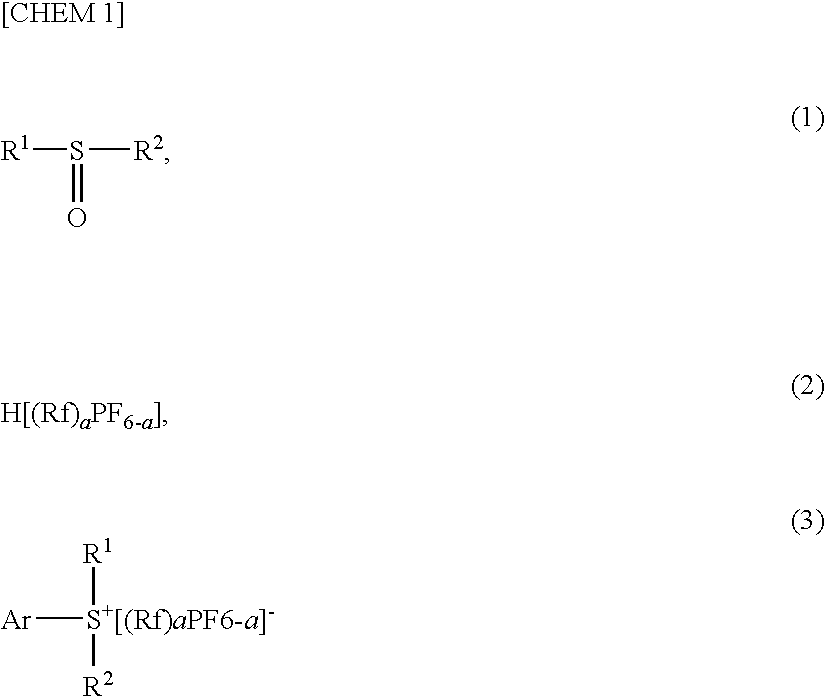Method for producing sulfonium fluorinated alkylfluorophosphate
a technology of fluorinated alkyl fluorophosphate and sulfonium fluorinated alkyl fluorophosphate, which is applied in the direction of photomechanical equipment, group 5/15 element organic compounds, instruments, etc., can solve the problems of inferior ability to initiate polymerization, limited use of initiators based on sb, and inability to use them in practical use, etc., to achieve excellent performance, low cost, and high efficiency
- Summary
- Abstract
- Description
- Claims
- Application Information
AI Technical Summary
Benefits of technology
Problems solved by technology
Method used
Image
Examples
example 1
Preparation of [4-(phenylthio)phenyl]diphenylsulfonium tris(pentafluoroethyl)-trifluorophosphate Salt
[0065]In a 100-mL reaction vessel were put 14.6 g of acetonitrile and 14.5 g (34.0 mmol) of tris(pentafluoroethyl)difluorophosphorane and mixed well, and 0.68 g (34.0 mmol) of hydrogen fluoride was added dropwise to this at 0 to 5° C. To this was added dropwise, at 10 to 20° C., a solution of 6.2 g (30.7 mmol) of diphenyl sulfoxide, 5.7 g (30.5 mmol) of diphenyl sulfide, and 9.7 g (95.0 mmol) of acetic anhydride dissolved in advance in 10.3 g of acetonitrile, and the mixture was stirred for 30 minutes. Then, following reaction for 7 hours at 40° C., the reaction mixture was cooled to room temperature, and to this was added 30 g of dichloromethane and mixed. This solution was washed with 60 g of water, and the organic phase was further washed three times with 20 g of water. Evaporation of dichloromethane then gave 25.9 g of pale yellow solid.
[0066]The solid thus obtained was found to ...
example 2
Preparation of [4-(phenylthio)phenyl]diphenylsulfonium tris(pentafluoroethyl)-trifluorophosphate Salt
[0068]In a 100-mL reaction vessel were put 18.3 g (37.8 mmol) of potassium tris(pentafluoroethyl)trifluorophosphate and 14.1 g of acetonitrile and mixed with stirring, and to this was added dropwise 3.8 g (38.7 mmol) of concentrated sulfuric acid, and the mixture was stirred for 30 minutes.
[0069]To this solution was added dropwise, at room temperature, a solution of 6.2 g (30.7 mmol) of diphenyl sulfoxide and 9.7 g (95.0 mmol) of acetic anhydride homogeneously dissolved in advance, and then 5.9 g (31.7 mmol) of diphenyl sulfide was added dropwise. Following reaction for 6 hours at 45° C., the reaction mixture was cooled to room temperature, and to this was added 30 g of dichloromethane and mixed. The solution was washed with 60 g of water, and the organic phase was further washed three times with 20 g of water. Evaporation of dichloromethane gave 24.8 g of pale yellow solid.
[0070]The...
example 3
Preparation of [4-(phenylthio)phenyl]diphenylsulfonium tris(pentafluoroethyl)-trifluorophosphate Salt
[0072]In a 100-mL reaction vessel were put 5.9 g (31.7 mmol) of diphenyl sulfide, 6.2 g (30.7 mmol) of diphenyl sulfoxide, 14.1 g of acetonitrile, 9.7 g (95.0 mmol) of acetic anhydride, and 18.3 g (37.8 mmol) of potassium tris(pentafluoroethyl)trifluorophosphate, and mixed with stirring for 30 minutes. To the solution thus obtained was added dropwise 3.8 g (38.7 mmol) of concentrated sulfuric acid while controlling the temperature of the solution not to rise beyond 45° C. Following reaction for 6 hours at 45° C., the reaction mixture was cooled to the room temperature, and to this was added 30 g of dichloromethane and mixed. The solution was washed with 60 g of water, and the organic phase was further washed three times with 20 g of water. Evaporation of dichloromethane gave 25.1 g of pale yellow solid.
[0073]The solid thus obtained was found to contain the aimed [4-(phenylthio)phenyl...
PUM
| Property | Measurement | Unit |
|---|---|---|
| storage stability | aaaaa | aaaaa |
| physical properties | aaaaa | aaaaa |
| adhesiveness | aaaaa | aaaaa |
Abstract
Description
Claims
Application Information
 Login to View More
Login to View More - R&D
- Intellectual Property
- Life Sciences
- Materials
- Tech Scout
- Unparalleled Data Quality
- Higher Quality Content
- 60% Fewer Hallucinations
Browse by: Latest US Patents, China's latest patents, Technical Efficacy Thesaurus, Application Domain, Technology Topic, Popular Technical Reports.
© 2025 PatSnap. All rights reserved.Legal|Privacy policy|Modern Slavery Act Transparency Statement|Sitemap|About US| Contact US: help@patsnap.com



